Picture this: You’re standing in your garden, watching your tomatoes flourish next to a patch of aromatic basil, while nearby, your corn stalks support climbing beans that are quietly enriching the soil for everyone. It’s not garden magic—it’s companion planting, and it might just be the secret weapon your garden has been waiting for.
I’ll never forget the first time I truly “got” companion planting. After years of fighting aphids on my pepper plants with every organic spray I could find, a neighbor suggested I plant some chives nearby.
Skeptical but desperate, I tucked a few chive plants around my pepper bed. Within weeks, the aphid problem virtually disappeared. That was my “aha” moment—plants really can help each other in remarkable ways.
Companion planting isn’t just some trendy gardening buzzword. It’s an ancient practice that recognizes something profound: in nature, plants don’t grow in isolation.
They form complex relationships, supporting each other through challenges while sharing resources and protection. When we recreate these partnerships in our gardens, we’re working with nature instead of against it.
What Is Companion Planting, Really?
At its heart, companion planting is about growing different plants together strategically so they benefit each other. Think of it as creating plant communities where everyone has a role to play.
One plant might repel pests that bother its neighbor, while another fixes nitrogen in the soil for everyone to share. Some provide physical support, shade, or ground cover, while others attract beneficial insects that keep the whole system healthy.
But here’s what makes companion planting so appealing: it’s not just about the plants helping each other—it helps you too. When your garden plants work as a team, you’ll find yourself dealing with fewer pest problems, better soil health, more efficient use of space, and often bigger, more flavorful harvests. It’s gardening with a wingman.
The practice works through several key mechanisms. Plants can release chemical compounds that either repel harmful insects or attract beneficial ones. Some plants improve soil conditions for their neighbors by fixing nitrogen or accessing deep nutrients.
Others provide physical benefits like shade, wind protection, or structural support. Understanding these mechanisms helps you choose the right partnerships for your specific garden needs.
The Science Behind Plant Partnerships
While much companion planting wisdom comes from generations of gardener observations, modern research is backing up many of these traditional practices.
Scientists have discovered that plants communicate through chemical signals, both above and below ground. Some release compounds that repel harmful insects, while others produce substances that actually help neighboring plants grow stronger.
For example, when researchers studied basil and tomato combinations, they found that basil doesn’t just repel pests through its strong scent—it actually helps tomato plants produce compounds that boost their natural defense systems.
The volatile oils released by basil prime tomato plants’ immune responses, making them more resistant to pest attacks and diseases.
Similarly, marigolds don’t just smell bad to certain pests; they release chemicals called thiophenes into the soil that can kill harmful nematodes. French marigolds are particularly effective, with some studies showing up to 90% reduction in root-knot nematodes when grown as companions.
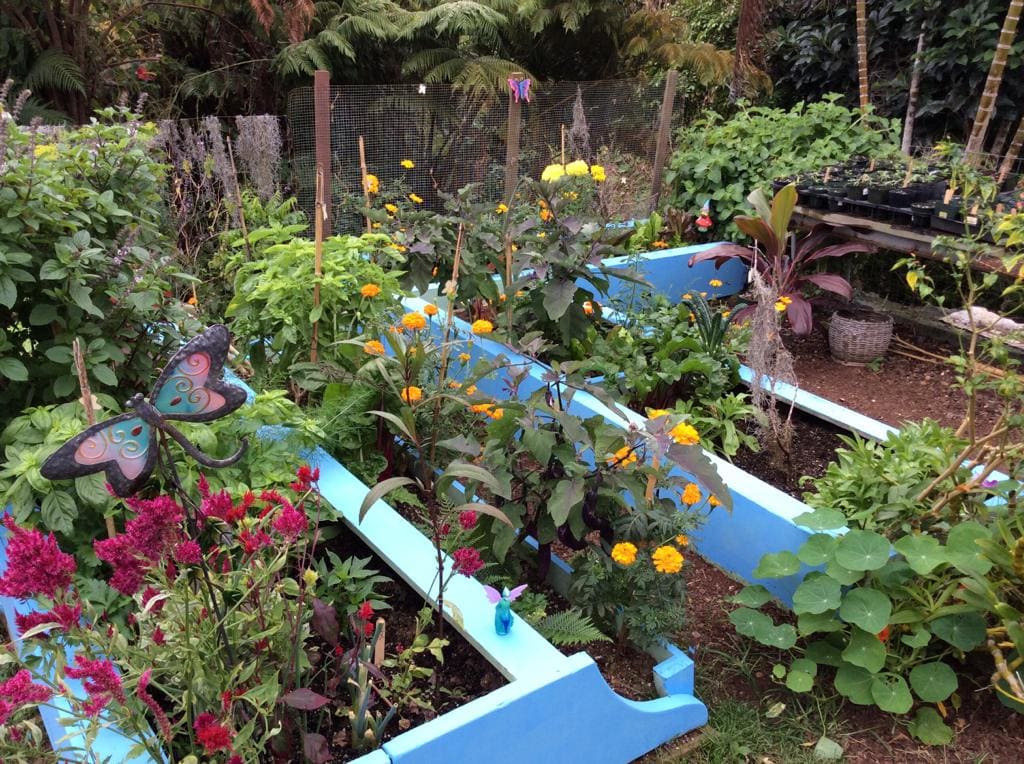
The key insight from recent research? Plant diversity matters enormously. Gardens with a variety of plants consistently show fewer pest problems and healthier soil than monoculture plantings. When you mix things up, you create an environment where beneficial insects thrive and pest insects struggle to establish themselves.
The Big Benefits: Why Your Garden Will Thank You
Natural Pest Control That Actually Works
Let’s be honest—dealing with garden pests can be exhausting. Companion planting offers a refreshingly hands-off approach to pest management. Instead of constantly spraying and monitoring, you can plant strategic partners that do the work for you.
Some plants act as “trap crops,” essentially volunteering themselves as pest bait to protect their neighbors. Nasturtiums, for instance, are irresistible to aphids, cucumber beetles, and cabbage worms. Plant them near your vegetables, and watch the pests flock to the nasturtiums instead of your precious crops.
The key is monitoring your trap crops and removing them when they become heavily infested to prevent pest populations from exploding.
Other plants work as natural repellents. The strong scents of herbs like rosemary, sage, and mint confuse and deter many insects. These aromatic compounds work by masking the scent signals that pest insects use to locate their preferred host plants.
I’ve seen gardeners dramatically reduce cabbage moth problems by simply interplanting their brassicas with aromatic herbs.
Visual disruption also plays a role. Flying pests often locate their host plants by sight, looking for specific leaf shapes and colors. When you intermix different plants with varying heights, textures, and colors, you make it much harder for pest insects to find their targets.
Soil Health That Builds Over Time
One of companion planting’s most valuable benefits is how it improves your soil naturally. Legumes like beans, peas, and clover have a superpower: they can pull nitrogen from the air and convert it into a form other plants can use. This process, called nitrogen fixation, essentially fertilizes your garden for free.
But the soil benefits go deeper. Plants with different root structures work together beautifully underground. Deep-rooted plants like carrots and tomatoes pull nutrients from lower soil layers and bring them closer to the surface when their leaves decompose.
Shallow-rooted plants like lettuce make efficient use of nutrients near the surface. This means less competition and more efficient nutrient cycling throughout your garden.
Different root types also improve soil structure in unique ways. Taprooted plants like carrots and radishes help break up compacted soil, creating channels for water and air movement. Fibrous-rooted plants like grasses help bind soil particles together, reducing erosion.
Smart Space Solutions for Any Garden Size
Whether you’re working with a sprawling backyard or a compact balcony garden, companion planting helps you make the most of every square inch. The key is understanding how different plants use space both above and below ground.
Fast-growing crops like radishes and lettuce can be harvested from between slower-maturing plants like broccoli or corn before they need the space. This succession approach lets you get multiple harvests from the same area throughout the season.
Vertical partnerships work wonders too. Tall plants provide natural support for climbers—think corn supporting beans, or sunflowers acting as living trellises for cucumbers. This eliminates the need for additional structures while maximizing your growing space.
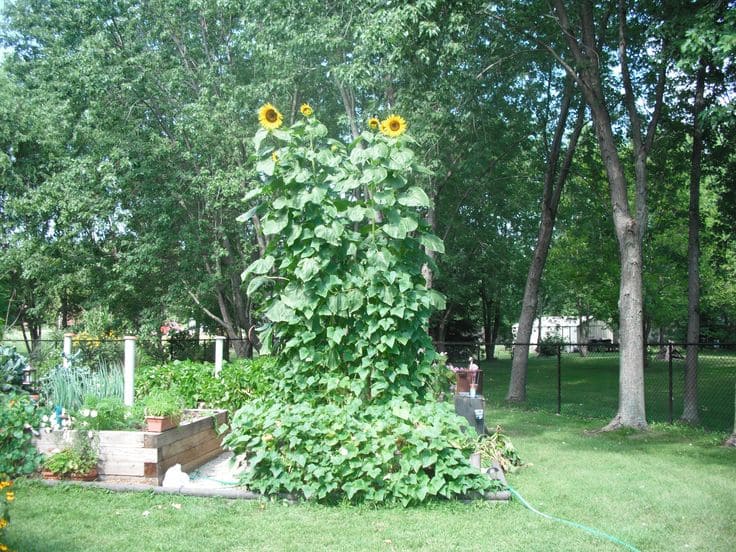
Meanwhile, ground-covering plants like squash spread below taller crops, suppressing weeds and maintaining soil moisture. The large leaves create a living mulch that reduces water needs and keeps soil temperatures stable.
Disease Prevention Through Plant Diversity
Monoculture plantings—growing large areas of the same crop—create ideal conditions for diseases to spread rapidly. When you diversify your plantings through companion strategies, you create natural barriers that slow disease transmission.
Some companion plants actively help prevent diseases. For instance, chives planted near roses can help prevent black spot and aphid infestations. The sulfur compounds in alliums have natural antifungal properties that protect nearby plants.
Mixed plantings also support beneficial soil microorganisms that compete with harmful pathogens. A diverse root zone environment encourages a healthy soil microbiome that helps plants resist diseases naturally.
Attracting the Good Guys: Building Beneficial Insect Habitat
A thriving garden ecosystem needs beneficial insects—pollinators, predators, and parasites that keep everything in balance. Companion planting creates habitat and food sources that draw these helpful creatures to your garden.
Different beneficial insects have different needs throughout their life cycles. Many need nectar for adult energy but hunt pest insects to feed their larvae. By providing a continuous succession of flowers throughout the growing season, you can support beneficial insect populations year-round.
Some of the most valuable beneficial insects are tiny and often overlooked. Parasitic wasps, for example, are smaller than gnats but incredibly effective at controlling pest insects. They lay their eggs inside aphids, caterpillars, and other pests, providing long-term natural pest control.
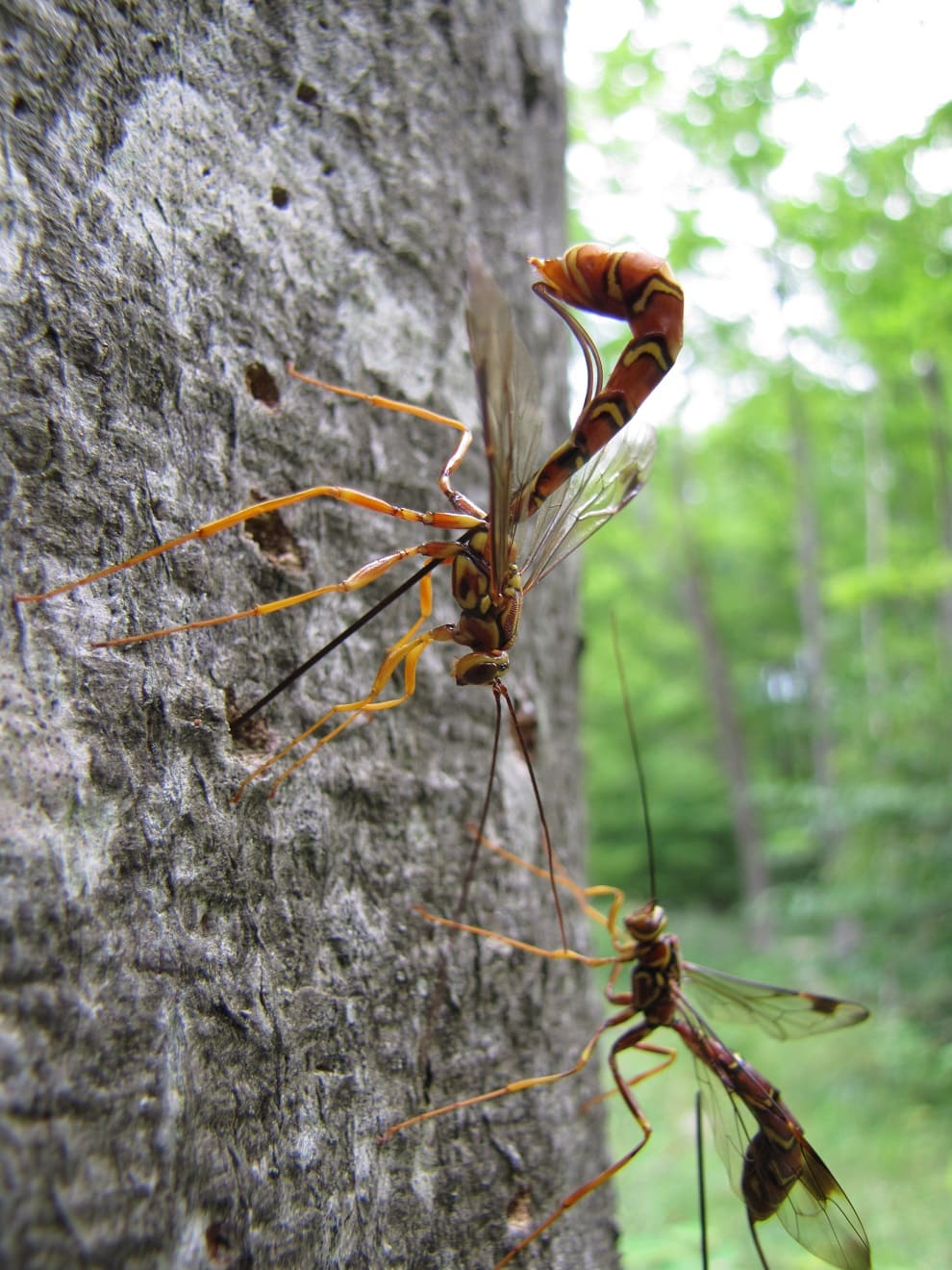
Read The Essential Wasp Identification Guide: 28 Common Types of Wasps In Your Garden
The All-Stars: Proven Companion Plant Combinations
The Three Sisters: Ancient Wisdom That Still Works
No discussion of companion planting would be complete without honoring the Three Sisters—corn, beans, and squash. This combination, developed by indigenous peoples thousands of years ago, remains one of the most elegant examples of plant partnership.
Here’s how the magic works: Corn provides a natural trellis for pole beans to climb. The beans, in return, fix nitrogen in the soil that feeds the corn and squash.
The squash spreads across the ground, its large leaves shading the soil to retain moisture and suppress weeds. Some squash varieties even have slightly prickly stems that deter small animals from munching on the corn.

For success with the Three Sisters, timing is crucial. Plant your corn first and let it reach 6-8 inches tall before adding the beans. This gives the corn a head start so it can support the beans’ weight. Plant 4-6 corn seeds in a circle about 18 inches across, then plant 4-6 bean seeds around the corn when it’s established.
Finally, plant 2-3 squash seeds about 3 feet away from the corn circle so they have room to spread.
Tomatoes and Basil: The Classic Kitchen Garden Duo
This pairing works beautifully both in the garden and on your dinner plate. Basil planted near tomatoes has been shown to improve tomato flavor and reduce pest problems. The basil’s strong scent masks the tomato’s aroma from harmful insects like hornworms and aphids.
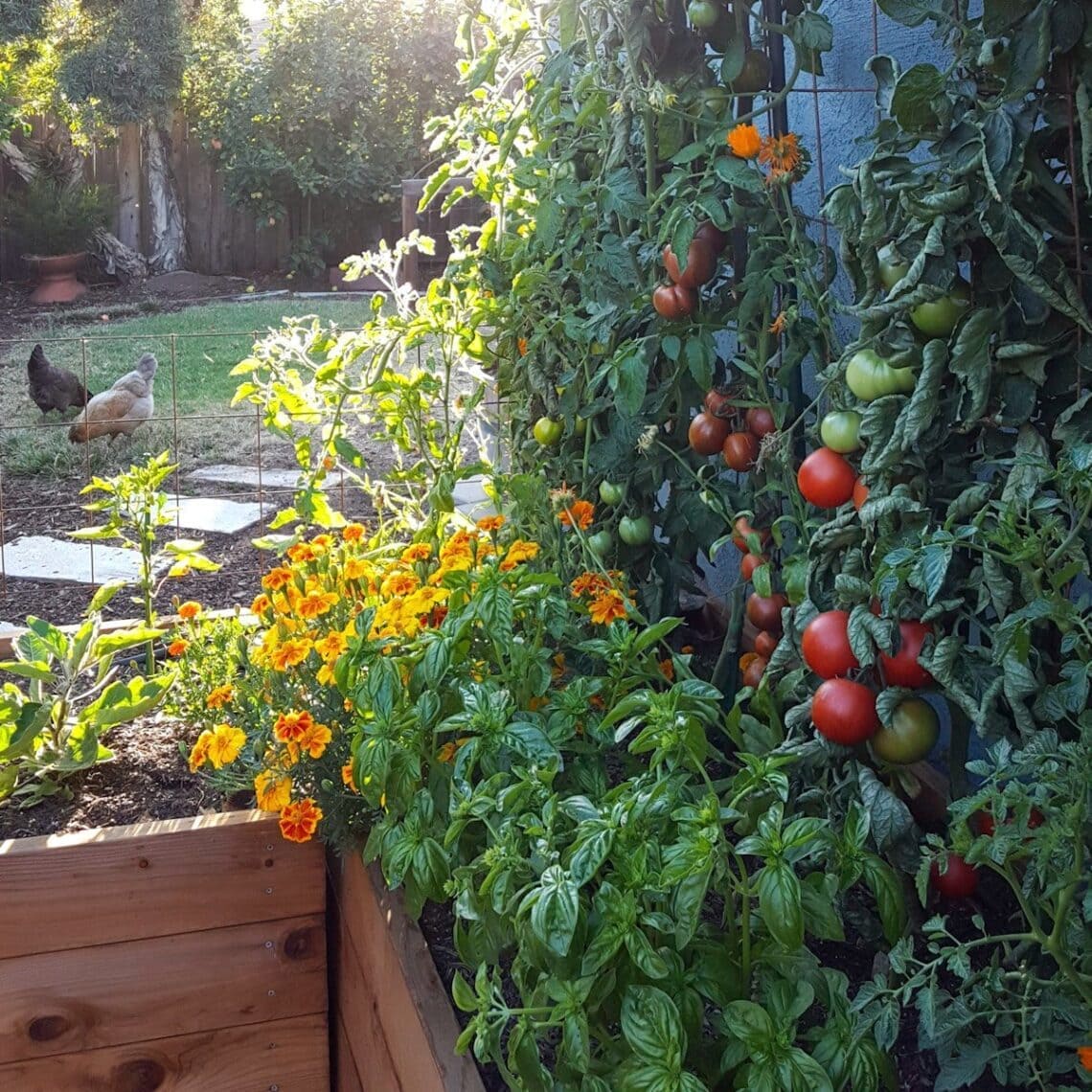
Research suggests that basil actually helps tomato plants produce more of their natural pest-deterrent compounds. The volatile oils from basil seem to “prime” the tomato plants’ defense systems, making them more resistant to insect damage.
For best results, plant basil about 12-18 inches from your tomato plants—close enough to provide protection but far enough to avoid root competition. You’ll need several basil plants per tomato to get the full pest-deterrent effect. A good ratio is 3-4 basil plants for every tomato plant.
Carrots and Onions: The Mutual Protection Society
This is one of my favorite combinations because it’s so elegantly simple. Carrot flies are repelled by the scent of onions, while onion flies are deterred by carrots. Plant them together, and both crops benefit from natural pest protection.
The different root depths work perfectly together too—carrots go deep (6-8 inches) while onions stay shallow (2-4 inches), so they’re not competing for the same soil space or nutrients. This makes efficient use of your garden’s three-dimensional space.
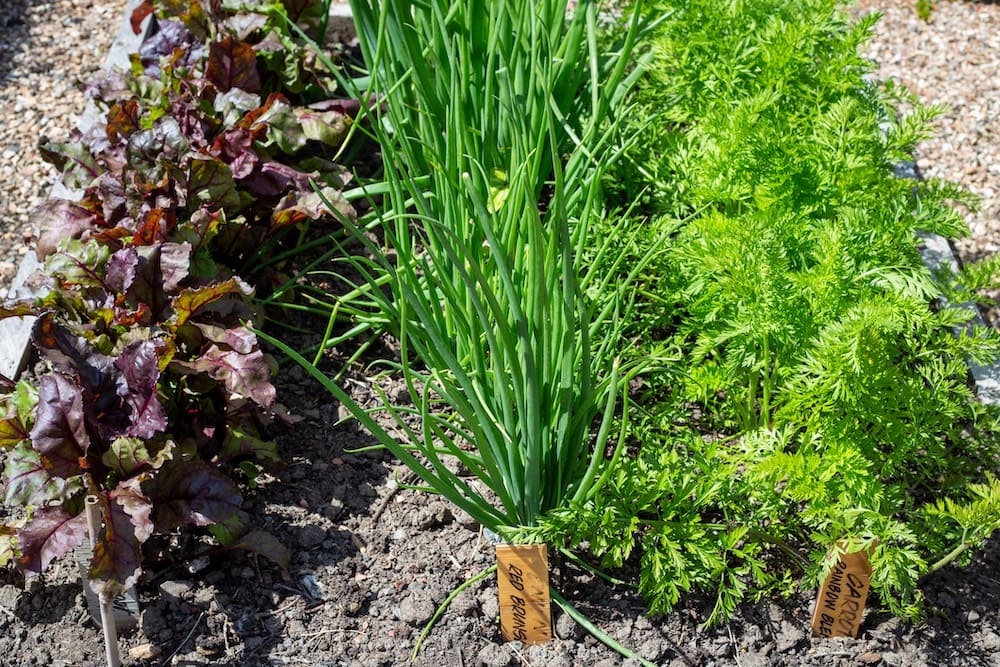
For optimal results, alternate rows of carrots and onions, or plant onions around the perimeter of carrot patches. You can also interplant onion sets directly in carrot rows, spacing them so they don’t interfere with carrot development.
Marigolds: The Garden’s Multi-Purpose Bodyguards
If there’s one flower every vegetable gardener should grow, it’s marigolds. These cheerful annuals are like security guards for your garden, providing multiple types of protection.

French marigolds (Tagetes patula) release compounds that repel whiteflies, aphids, and certain beetles. Even better, their roots secrete substances that kill harmful soil nematodes. Studies have shown that growing French marigolds can reduce root-knot nematode populations by up to 90%.
Mexican marigolds (Tagetes erecta) have similar properties and may also help repel rabbits and other small mammals. Both types attract beneficial insects like hoverflies and parasitic wasps.
Plant marigolds throughout your vegetable beds, especially near tomatoes, peppers, and eggplants. Space them about 18-24 inches apart for effective coverage. The flowers also add bright color and attract pollinators to your garden.
Complete Companion Planting Reference Chart
While the combinations above represent some of the most proven and popular partnerships, the world of companion planting offers hundreds of beneficial plant relationships.
The comprehensive chart below serves as your complete reference guide for planning any garden layout, troubleshooting plant problems, or discovering new combinations to try.
This research-backed chart includes every companion relationship from traditional gardening wisdom and modern scientific studies. Bookmark this section—you’ll find yourself returning to it throughout your gardening seasons.
How to Use This Chart
This comprehensive chart includes companion plant relationships gathered from multiple research sources. Use it alongside the main companion planting guide to plan your garden layouts and plant partnerships.
Chart Key:
- Companions = Plants that benefit each other when grown together
- Avoid = Plants that should not be grown near each other
- Benefits = Primary reasons why the partnership works
Vegetables
Asparagus
- Companions: Basil, calendula, coriander, dill, marigolds, oregano, parsley, petunias, tomatoes
- Avoid: Garlic, onions, potatoes
- Benefits: Marigold and petunias deter asparagus beetles; tomatoes repel asparagus beetles while asparagus repels nematodes
Beans (Bush)
- Companions: Beets, broccoli, Brussels sprouts, cabbage, carrots, catnip, cauliflower, celery, corn, cucumber, eggplant, kale, marigolds, nasturtiums, peas, potatoes, radishes, rosemary, squash, strawberries, summer savory, tomatoes
- Avoid: Chives, garlic, gladiolus, onions, shallots
- Benefits: Catnip repels flea beetles; marigolds deter Mexican bean beetles; summer savory improves growth and flavor
Beans (Pole/Climbing)
- Companions: Broccoli, cabbage, carrots, catnip, cauliflower, celery, corn, cucumber, eggplant, marigolds, nasturtiums, peas, potatoes, radishes, rosemary, squash, strawberries, sunflowers, tomatoes
- Avoid: Beets, chives, garlic, onions, shallots
- Benefits: Corn provides natural trellis; beans fix nitrogen for soil
Beets
- Companions: Broccoli, Brussels sprouts, bush beans, cabbage, cauliflower, garlic, kohlrabi, leeks, lettuce, onions
- Avoid: Pole beans, spinach, chard (same family – Beta vulgaris)
- Benefits: Garlic improves growth and flavor; add magnesium to soil when composted
Broccoli
- Companions: Alyssum, basil, beets, celery, chamomile, Chinese cabbage, cucumber, dill, garlic, lettuce, marigolds, mint, nasturtiums, onions, oregano, potato, radishes, rosemary, sage, spinach, thyme
- Avoid: Asparagus, pole beans, corn, melons, mustard, peppers, pumpkins, squash, strawberries, tomatoes
- Benefits: Dill attracts beneficial wasps; rosemary repels cabbage fly; sage reduces diamondback moth
Brussels Sprouts
- Companions: Basil, beans, beets, carrots, garlic, mint, nasturtiums, onions, peas, sage, thyme
- Avoid: Pole beans, strawberries, tomatoes
- Benefits: Aromatic herbs repel cabbage pests; mint deters flea beetles
Cabbage
- Companions: Beans (bush), beets, celery, chamomile, dill, garlic, mint, nasturtiums, onions, oregano, rosemary, sage, tansy, thyme
- Avoid: Grapes, pole beans, mustard, strawberries, tomatoes
- Benefits: Chamomile deters pests; tansy and thyme disrupt egg-laying behavior of cabbage worms
Carrots
- Companions: Beans, chives, leeks, lettuce, onions, peas, peppers, radishes, rosemary, sage, tomatoes
- Avoid: Dill, parsnips, potatoes
- Benefits: Chives improve growth and flavor; rosemary and sage deter carrot fly; onions mask scent from carrot fly
Cauliflower
- Companions: Beans, beets, broccoli, Brussels sprouts, celery, corn, onions, radishes, spinach
- Avoid: Dill, parsnips, radishes, strawberries
- Benefits: Similar benefits to other brassicas; onions provide pest protection
Celery
- Companions: Beans, cabbage family, leeks, onions, tomatoes
- Avoid: Carrots, parsnips, potatoes
- Benefits: Chives and garlic deter aphids; nasturtiums repel various pests
Corn (Sweet)
- Companions: Beans, cucumbers, dill, geraniums, melons, parsley, peas, potatoes, pumpkins, squash, sunflowers
- Avoid: Celery, tomatoes
- Benefits: Provides support for climbing plants; geraniums attract and paralyze Japanese beetles
Cucumbers
- Companions: Beans, borage, cabbage family, corn, dill, lettuce, marigolds, nasturtiums, oregano, peas, radishes, sunflowers, tansy
- Avoid: Aromatic herbs (except dill), potatoes, sage
- Benefits: Dill repels aphids and mites; nasturtiums trap cucumber beetles; radishes repel cucumber beetles
Eggplant
- Companions: Beans, catnip, marigolds, peas, peppers
- Avoid: Fennel, potatoes, tomatoes (nightshade family – disease spread)
- Benefits: Catnip repels flea beetles; marigolds deter nematodes
Garlic
- Companions: Beets, broccoli, cabbage, carrots, cauliflower, dill, eggplant, kohlrabi, peppers, potatoes, spinach, tomatoes
- Avoid: Asparagus, beans, parsley, peas, sage
- Benefits: Repels wide range of pests including aphids, beetles, and root maggots
Kale
- Companions: Beets, beans, celery, cucumber, dill, garlic, lettuce, mint, onions, peas, peppers, potatoes, rosemary, sage, spinach
- Avoid: Other brassicas (disease prevention), peppers
- Benefits: Similar pest protection as other brassicas; aromatic herbs provide protection
Kohlrabi
- Companions: Beets, onions
- Avoid: Beans, peppers, strawberries, tomatoes
- Benefits: Compact growth works well with root crops
Leeks
- Companions: Beets, carrots, celery, onions, spinach, strawberries
- Avoid: Beans, peas, parsley
- Benefits: Repel carrot rust fly and other flying pests
Lettuce
- Companions: Asparagus, basil, beans, beets, broccoli, Brussels sprouts, carrots, chives, corn, cucumbers, eggplant, garlic, mint, onions, peas, radishes, spinach, strawberries, tomatoes
- Avoid: Cabbage, celery, parsley
- Benefits: Chives and garlic deter aphids; mint repels slugs and cabbage moths
Melons
- Companions: Corn, pumpkins, radishes, squash
- Avoid: Potatoes
- Benefits: Corn provides structure; radishes improve soil and deter pests
Onions
- Companions: Beets, broccoli, Brussels sprouts, cabbage, carrots, chamomile, lettuce, peppers, strawberries, tomatoes
- Avoid: Asparagus, beans, peas, sage
- Benefits: Chamomile and summer savory improve flavor; repel many pest insects
Parsnips
- Companions: Garlic, sweet corn
- Avoid: Carrots, celery, lettuce, potatoes
- Benefits: Deep roots don’t compete with shallow-rooted companions
Peas
- Companions: Alyssum, beans, carrots, celery, chives, corn, cucumbers, eggplant, lettuce, mint, potatoes, radishes, spinach, tomatoes, turnips
- Avoid: Chives, garlic, onions, shallots
- Benefits: Fix nitrogen; alyssum attracts beneficial insects; mint improves health and flavor
Peppers
- Companions: Basil, beans, beets, carrots, chives, coriander, cucumbers, dill, eggplant, garlic, lettuce, marjoram, onions, oregano, spinach, tomatoes
- Avoid: Brassicas (broccoli, Brussels sprouts, cabbage, cauliflower), fennel
- Benefits: Basil improves flavor and deters pests; herbs provide natural insect protection
Potatoes
- Companions: Basil, beans, cabbage, chamomile, cilantro, corn, garlic, horseradish, lettuce, marigolds, parsley, peas, radishes, spinach, thyme
- Avoid: Asparagus, carrots, cucumbers, eggplant, fennel, onions, pumpkins, raspberries, squash, sunflowers, tomatoes, turnips
- Benefits: Horseradish increases disease resistance; herbs enhance flavor
Pumpkins
- Companions: Beans (pole), buckwheat, calendula, corn, lovage, marigolds, nasturtiums, oregano
- Avoid: Potatoes
- Benefits: Pole beans provide nitrogen; marigolds deter beetles; nasturtiums repel squash bugs
Radishes
- Companions: Beans, beets, carrots, chervil, cucumbers, lettuce, melons, nasturtiums, peas, spinach, squash
- Avoid: Brassicas (broccoli, Brussels sprouts, cabbage, cauliflower), hyssop
- Benefits: Break up soil; act as trap crop for flea beetles; chervil improves growth
Spinach
- Companions: Beans, beets, celery, cilantro, eggplant, lettuce, oregano, peas, rosemary, strawberries
- Avoid: Potatoes
- Benefits: Benefits from nitrogen-fixing companions; herbs provide pest protection
Squash (Summer & Winter)
- Companions: Beans, borage, buckwheat, calendula, corn, dill, marigolds, nasturtiums, oregano, peas, radishes, sunflowers, zinnia
- Avoid: Potatoes
- Benefits: Buckwheat brings predators; nasturtiums repel squash bugs; borage improves pollination
Swiss Chard
- Companions: Beans, beets, cabbage family, onions
- Avoid: None specifically noted
- Benefits: Similar to beets in soil mineral contribution
Tomatoes
- Companions: Asparagus, basil, borage, calendula, carrots, celery, chives, cucumber, garlic, lettuce, marigolds, mint, nasturtiums, onions, parsley, peppers
- Avoid: Brassicas, corn, dill, fennel, kohlrabi, potatoes
- Benefits: Basil improves growth and flavor; marigolds repel whiteflies; asparagus repels nematodes
Turnips
- Companions: Peas
- Avoid: Potatoes
- Benefits: Root crops work well with nitrogen-fixing peas
Herbs & Flowers
Alyssum (Sweet)
- Companions: Lettuce, peas, potatoes
- Benefits: Attracts hoverflies and lacewings that eat aphids; provides ground cover
Basil
- Companions: Asparagus, beets, borage, carrots, chamomile, chives, marigolds, oregano, peppers, radishes, tomatoes, turnips
- Avoid: Cucumber, fennel, rue, sage, thyme
- Benefits: Repels flies, mosquitoes, aphids, and tomato hornworms; improves tomato yields
Borage
- Companions: Squash, strawberries, tomatoes
- Avoid: None specifically noted
- Benefits: Attracts pollinators; repels tomato hornworms; improves strawberry yield
Calendula
- Companions: Asparagus, mint, sage, tomatoes, potatoes, pumpkins
- Benefits: Repels beetles and nematodes; attracts beneficial insects
Chamomile
- Companions: Cabbage, onions
- Benefits: Deters flies and mosquitoes; strengthens neighboring plants
Chives
- Companions: Apples, carrots, cucumbers, lettuce, peas, roses, tomatoes
- Avoid: Beans, peas
- Benefits: Prevents apple scab; deters aphids and carrot rust fly
Cilantro/Coriander
- Companions: Asparagus, peppers, potatoes
- Avoid: Dill (cross-pollination)
- Benefits: Repels aphids, potato beetles, and spider mites
Cosmos
- Companions: General garden companion
- Benefits: Attracts beneficial insects including parasitic wasps and hoverflies
Dill
- Companions: Broccoli, Brussels sprouts, cabbage, corn, cucumbers, lettuce, onions
- Avoid: Carrots, cilantro, tomatoes
- Benefits: Attracts ladybugs and beneficial wasps; repels aphids and cabbage loopers
Lavender
- Companions: Lettuce, onions, tomatoes, oregano, sage, rosemary, basil
- Benefits: Repels various pests; attracts pollinators
Marigolds (French)
- Companions: Most vegetables, especially tomatoes, peppers, eggplants
- Avoid: Beans
- Benefits: Kill root-knot nematodes; repel whiteflies and aphids
Mint
- Companions: Beets, broccoli, Brussels sprouts, cabbage, cauliflower, eggplant, kale, lettuce, peas, squash, tomatoes
- Avoid: Chamomile, parsley
- Benefits: Repels ants, aphids, flea beetles, and cabbage moths
Nasturtiums
- Companions: Beans, brassicas, cucumbers, fruit trees, radishes, tomatoes, zucchini
- Avoid: None specifically noted
- Benefits: Trap crop for aphids and cucumber beetles; repels various pests
Oregano
- Companions: Asparagus, basil, peppers, pumpkins, grapes
- Benefits: Natural insecticide properties; attracts beneficial insects
Parsley
- Companions: Asparagus, corn, sweet corn, tomatoes
- Avoid: Lettuce, mint
- Benefits: Attracts beneficial insects; deters asparagus beetles
Rosemary
- Companions: Beans, brassicas, carrots, cauliflower, kale
- Avoid: Pumpkins, squash
- Benefits: Repels bean beetles, cabbage moths, and carrot rust fly
Sage
- Companions: Brassicas, carrots, rosemary
- Avoid: Cucumbers
- Benefits: Repels cabbage white butterfly and carrot flies
Sunflowers
- Companions: Beans, corn, cucumbers, squash
- Avoid: Pole beans, potatoes
- Benefits: Provide natural support; attract beneficial insects and pollinators
Tansy
- Companions: Potatoes, pumpkins
- Benefits: Repels ants, beetles, and Colorado potato beetles
Thyme
- Companions: Brassicas, potatoes, strawberries, Brussels sprouts
- Benefits: Deters cabbage worms and weevils; enhances strawberry flavor
Yarrow
- Companions: Most aromatic herbs
- Benefits: Enhances essential oil production in nearby herbs; attracts beneficial insects
Zinnia
- Companions: General garden companion, especially summer squash
- Benefits: Attracts ladybugs and other beneficial insects; provides continuous blooms
Specialty Combinations
Three Sisters Traditional
- Plants: Corn, pole beans, winter squash
- Benefits: Corn supports beans; beans fix nitrogen; squash suppresses weeds and provides ground cover
Pollinator Support Mix
- Plants: Cosmos, calendula, zinnia, sweet alyssum, borage
- Benefits: Continuous blooms attract and support beneficial insects throughout season
Natural Pest Control Border
- Plants: Marigolds, nasturtiums, chives, mint (contained), tansy
- Benefits: Creates protective barrier around main crops
Soil Building Combination
- Plants: Clover, beans, peas, comfrey
- Benefits: Nitrogen fixation and deep nutrient mining improve soil health
Quick Reference Notes
Best Universal Companions:
- Marigolds (pest control, soil health)
- Nasturtiums (trap crops, pest deterrent)
- Basil (pest control, flavor enhancement)
- Beans (nitrogen fixation)
- Herbs in general (pest control, beneficial insects)
Plants to Keep Separate:
- Fennel (inhibits most vegetables)
- Black walnut trees (toxic to many plants)
- Beans and alliums (onion family)
- Tomatoes and brassicas (different pH needs)
Container-Friendly Combinations:
- Tomatoes + basil + marigolds
- Peppers + chives + nasturtiums
- Lettuce + radishes + sweet alyssum
- Herbs together (basil, oregano, thyme)
Season Extenders:
- Tall plants providing shade for cool-season crops
- Ground covers maintaining soil temperature
- Wind barriers protecting tender plants
This chart compiles companion planting relationships from multiple research sources. Results may vary based on local conditions, climate, and specific varieties. Always consider your garden’s unique environment when planning companion combinations.
Strategic Timing: When to Plant What
Early Season Partnerships
Start your companion planting season with cool-weather partnerships. Plant peas and spinach together in early spring—the peas fix nitrogen that the spinach can use, while both crops prefer cool conditions.
Radishes make excellent early companions for slower-germinating crops like carrots and parsnips. The radishes break up the soil as they grow and are ready to harvest just as the root crops need more space.
Mid-Season Transitions
As your cool-season crops finish, transition to warm-season partnerships. This is when you’ll plant your tomato-basil combinations, corn-bean partnerships, and summer squash with their protective nasturtium companions.
Time your plantings so that nitrogen-fixing plants like beans have a chance to establish before planting heavy feeders like corn or squash nearby.
Late Season Planning
Late summer is perfect for planting cover crop companions that will improve your soil for next year. Crimson clover, winter rye, and other cover crops can be planted between finishing summer crops to prevent soil erosion and add organic matter.

Understanding Plant Spacing and Proportions
Getting companion plant spacing right is crucial for success. Too close, and plants compete for resources. Too far apart, and you lose the companion benefits.
For pest control companions like basil with tomatoes, plant within 18-24 inches for maximum effectiveness. For soil-building companions like nitrogen-fixing plants, the benefits can extend 3-4 feet in all directions.
When using trap crops, plant them slightly closer to your main crops than you would normally space plants. You want the pests to find the trap crop first, but not so close that problems can easily spread to your main vegetables.
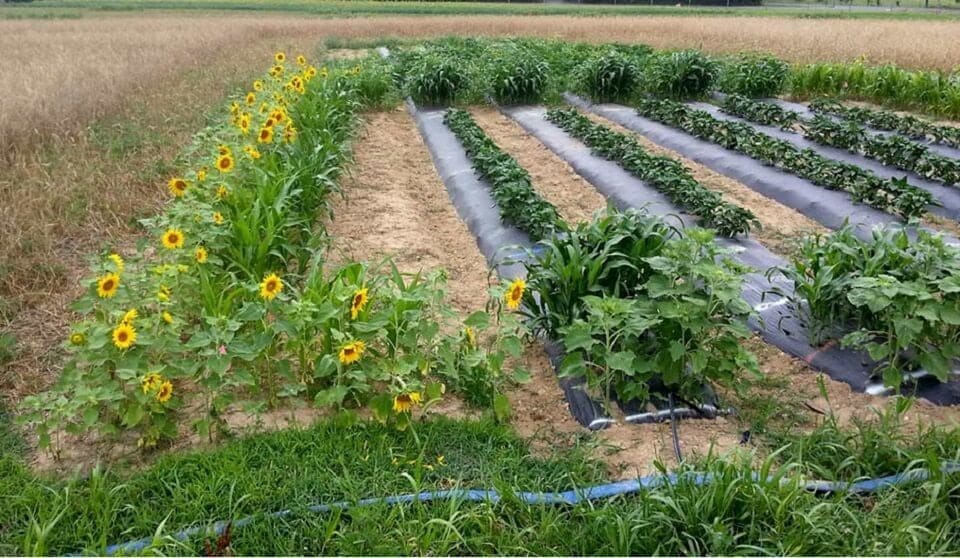
Consider mature plant sizes when planning spacing. A small basil seedling will eventually bush out to 12-18 inches wide, so plan accordingly.
Working with Different Growing Conditions
Soil pH Considerations
Different plants prefer different soil pH levels, and this affects companion plant success. Tomatoes, peppers, and eggplants prefer slightly acidic soil (pH 6.0-6.8), while brassicas like cabbage and broccoli prefer neutral to slightly alkaline soil (pH 6.5-7.5).
When planning companions, group plants with similar pH preferences together. If you must grow plants with different pH needs near each other, consider using raised beds or containers to create distinct growing environments.
Water Needs and Irrigation Planning
Successful companion planting requires matching plants with similar water needs. Mediterranean herbs like rosemary and oregano prefer drier conditions, while leafy greens need consistent moisture.
Group plants with similar water requirements together to make irrigation more efficient. If you’re using drip irrigation, design your system to accommodate different watering zones.

Deep-rooted and shallow-rooted companions can sometimes share water resources effectively, with the deep-rooted plants accessing water from lower soil layers while shallow-rooted plants use surface moisture.
Sun and Shade Partnerships
Use natural shade relationships to your advantage. Tall plants like corn, sunflowers, or trellised tomatoes can provide afternoon shade for heat-sensitive crops like lettuce and spinach.
This is especially valuable in hot climates where cool-season crops can bolt quickly in full sun. Strategic shading can extend your harvest season for these crops.
Consider the seasonal changes in sun angles when planning shade relationships. A location that receives morning shade in summer might be in full sun during spring and fall.
Advanced Companion Strategies
Succession Planting for Continuous Benefits
Plan your companions in waves throughout the season. Start with cool-season partners, transition to warm-season combinations, and finish with cover crops that prepare the soil for next year.
Fast-growing companions like radishes and lettuce can be replanted every 2-3 weeks to provide continuous benefits and harvests throughout the season.
Creating Pollinator Corridors
Design your companion plantings to create corridors of flowering plants that bloom in succession throughout the growing season. This provides continuous habitat for beneficial insects and pollinators.
Include native flowering plants in your companion strategies—they’re often more attractive to local beneficial insects than non-native varieties.
The Polyculture Approach
Advanced companion planters often grow three or more compatible plants together in polyculture systems. A successful polyculture might include tomatoes for the main crop, basil for pest control, nasturtiums for trap cropping, and marigolds for soil health.

These complex plantings require more planning but can create incredibly resilient and productive growing systems.
Troubleshooting Common Challenges
When Companions Don’t Work as Expected
Not every companion combination works in every garden. Regional climate differences, local pest populations, and specific growing conditions can all affect plant relationships.
If a recommended combination isn’t working for you, try adjusting the spacing, timing, or varieties. Sometimes the issue isn’t the plant pairing but other factors like soil nutrition or water stress.
Keep detailed garden records to track which combinations work best in your specific conditions. Your garden’s unique environment will determine which partnerships are most successful.
Managing Aggressive Companions
Some beneficial companion plants can become overly enthusiastic. Mint, for example, is excellent for pest control but can quickly take over a garden bed if not managed properly.
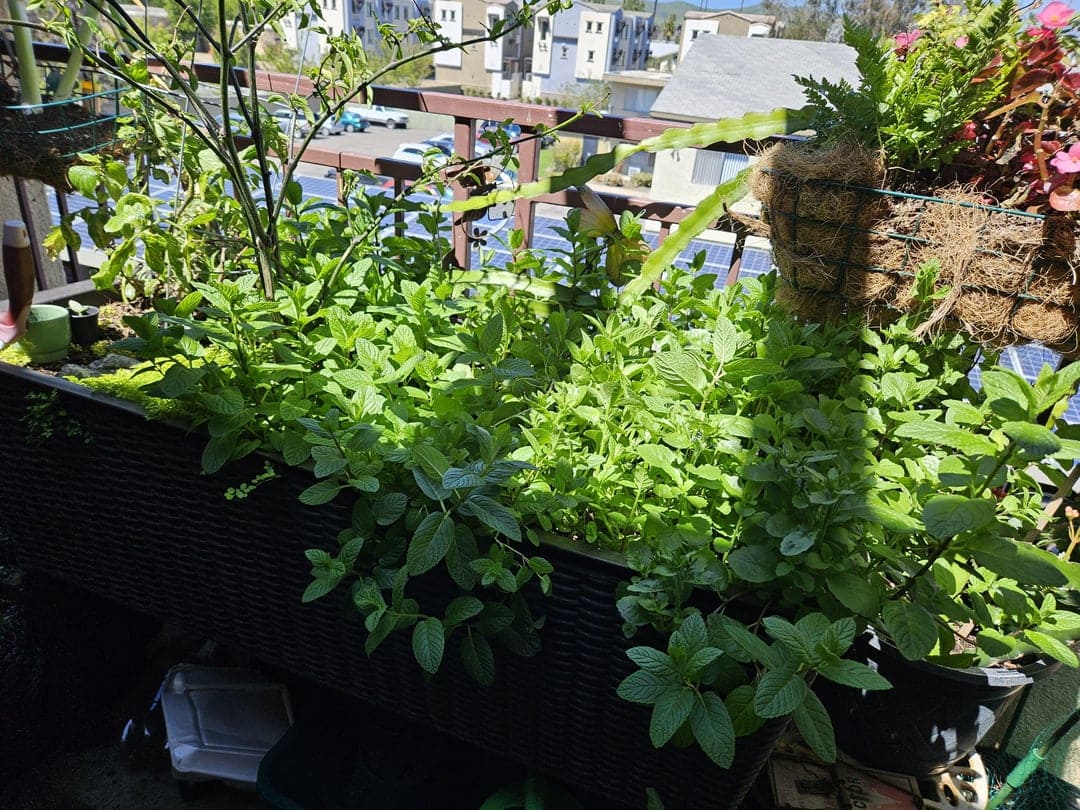
Solutions for aggressive companions include:
- Growing them in containers placed near your main crops
- Using them as living mulch that you harvest regularly
- Creating physical barriers in the soil to limit root spread
- Choosing less aggressive varieties or species
Balancing Harvest Timing
When companion plants mature at different rates, plan your harvests carefully. Quick-growing crops like radishes might be ready while their slower companions are just getting established.
Use succession planting to stagger harvests and maintain continuous companion benefits. As you harvest fast-growing companions, you can replant the same area or transition to different seasonal companions.
Find out When and How to Harvest Vegetables for Peak Flavor: Timing and Tips for Every Crop
Regional Considerations and Climate Adaptation
Hot Climate Strategies
In hot, dry climates, focus on companions that provide shade and conserve moisture. Heat-tolerant herbs like oregano and thyme can protect more sensitive vegetables from intense sun.
Use ground-covering companions like squash or sweet potatoes to shade soil and reduce water evaporation. These living mulches can significantly reduce irrigation needs.
Cold Climate Approaches
In northern gardens with short growing seasons, choose companions that mature quickly or provide season extension benefits. Row covers and cold frames work well with companion plantings to extend the growing season.

Focus on companions that help plants establish quickly in spring, such as nitrogen-fixing plants that give nearby crops a growth boost early in the season.
Humid Climate Considerations
In humid climates where fungal diseases are common, choose companions that improve air circulation and have natural antifungal properties.
Avoid overcrowding companion plantings in humid conditions—good air circulation is crucial for preventing disease problems.
Essential Companion Plants for Every Garden
The Must-Have Pest Controllers
- Marigolds top the list for their nematode control and general pest deterrent properties. Plant them throughout your garden for broad-spectrum protection.
- Nasturtiums work as excellent trap crops and add edible flowers to your garden. They’re particularly valuable near cucumbers, squash, and brassicas.
- Chives and other alliums provide excellent pest control for a wide range of crops. Their compact size makes them easy to tuck into small spaces throughout your garden.
The Soil Builders
- Bush beans are perfect for adding nitrogen while taking up minimal space. They’re compatible with most vegetables and provide a bonus food crop.
- Clover can be used as a living mulch or cover crop. White clover is particularly good for pathways or between beds where you want low-growing ground cover.
- Comfrey has deep roots that bring up nutrients from subsoil layers. Its leaves make excellent compost material or liquid fertilizer.
The Beneficial Insect Attractors
- Sweet alyssum blooms continuously and attracts tiny beneficial wasps that control aphids. It works well as an edging plant or ground cover.
- Cosmos are easy to grow and extremely attractive to beneficial insects. They bloom until frost and self-seed readily.
- Dill and cilantro provide nectar when allowed to flower and are useful culinary herbs. Let some plants go to seed for continuous beneficial insect habitat.
Container and Small Space Companion Planting
Maximizing Limited Space
Container companion planting requires careful attention to spacing and root zone management. Choose compact varieties and focus on compatible growth habits.
Vertical combinations work especially well in containers. Try cherry tomatoes with basil, or use a trellis to grow beans with lettuce planted around the base.
Succession Container Planting
In containers, you can easily implement succession planting by replacing finished crops with seasonal companions. Start with cool-season partnerships, then transition to warm-season combinations as the weather warms.
Window boxes and small containers are perfect for herb-vegetable companions like basil with cherry tomatoes or chives with lettuce.
Seasonal Maintenance and Care
Spring Setup
Begin your companion planting season by preparing soil and planning layouts. Test soil pH and amend as needed for your chosen companion combinations.
Start cool-season companions early, focusing on nitrogen-fixing plants that will benefit later warm-season crops.
Summer Management
Monitor pest levels and adjust companion strategies as needed. Remove trap crops when they become heavily infested, and replant quick-growing companions for continuous protection.
Maintain adequate spacing as plants grow, and thin or harvest components as needed to prevent overcrowding.
Read about Chop and Drop Gardening: Build Healthy Soil the Easy Way
Fall Transition
As summer crops finish, plant cover crop companions to improve soil for next year. Crimson clover, winter rye, and radishes can all provide soil benefits through winter.
Save seeds from successful companion plants for next year’s garden, and take notes on which combinations worked best in your specific conditions.
Frequently Asked Questions
- Q: How close should companion plants be to each other?
A: For pest control effects, companions usually need to be within 18-36 inches of the plants they’re protecting. For soil benefits like nitrogen fixation, the effects can extend 3-4 feet. Always respect each plant’s mature size requirements—overcrowding eliminates companion benefits.
- Q: Can I use companion planting in containers?
A: Absolutely! Container companion planting can be very effective, especially for herb-vegetable combinations. Try basil with cherry tomatoes, marigolds with peppers, or lettuce with taller plants that provide afternoon shade. Ensure your container is large enough—at least 5 gallons for most vegetable combinations.
- Q: What if I don’t have space for all these different plants?
A: Start with multi-purpose companions that serve several functions. Herbs like basil provide pest control, culinary value, and pollinator habitat. Marigolds offer pest control and beautiful flowers. Even a few strategically placed companion plants can make a significant difference.
- Q: Do companion plants really work, or is it just garden folklore?
A: While not every traditional pairing has scientific backing, many do. Research has confirmed benefits for combinations like marigolds reducing nematodes, diverse plantings reducing pest pressure, and legumes improving soil nitrogen. The key is understanding that companion planting works through multiple mechanisms, not magic.
- Q: How do I know if companion planting is working in my garden?
A: Look for reduced pest damage, healthier plant growth, improved soil conditions, and increased beneficial insect activity. Keep garden records comparing areas with and without companion plants. Success may be subtle—fewer pest problems rather than dramatic changes.
- Q: Can I practice companion planting organically?
A: Companion planting is inherently organic—it relies on natural plant relationships rather than synthetic inputs. It actually enhances organic gardening by providing natural pest control, soil improvement, and ecosystem support without chemicals.
- Q: What’s the biggest mistake beginners make with companion planting?
A: Overcrowding is the most common mistake. Cramming too many plants together eliminates the benefits and creates competition for resources. Give each plant adequate space to thrive, and remember that companion benefits come from strategic placement, not cramming plants together.
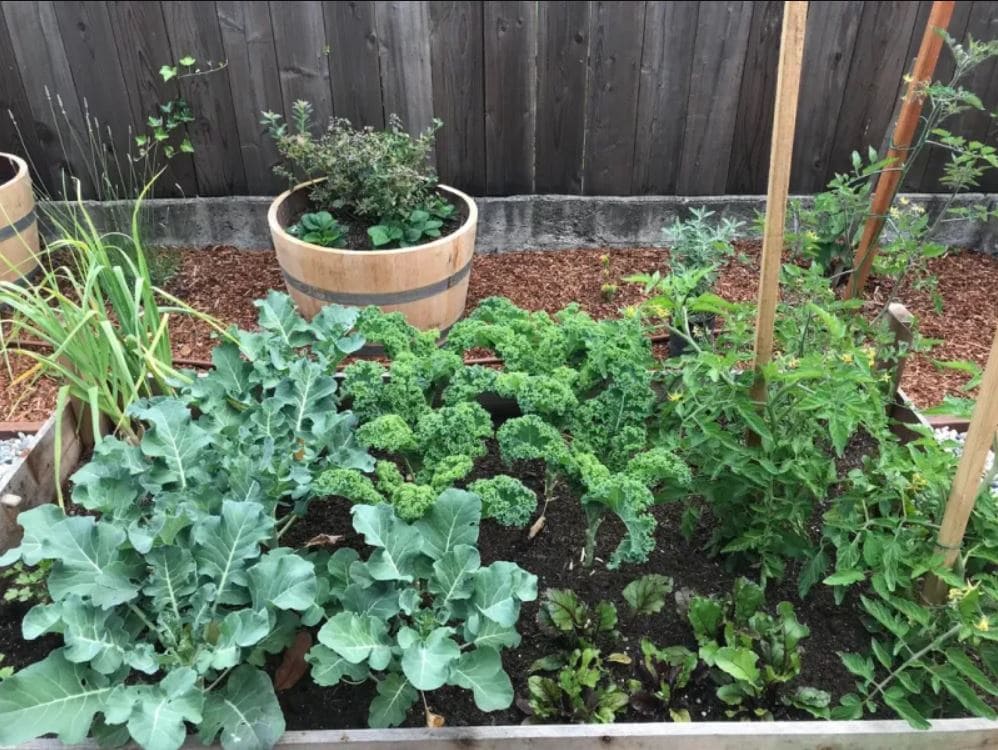
Conclusion: Growing a Garden Community
Companion planting transforms gardening from a series of individual plant struggles into a collaborative community effort. When you start thinking of your garden as an ecosystem where every plant has a role to play, something magical happens.
Plants grow stronger, pests become manageable, soil health improves naturally, and you develop a deeper understanding of how nature works.
The beauty of companion planting is that it grows with you. Each season teaches you something new about plant relationships, and every garden challenge becomes an opportunity to find creative partnerships.
You’ll find yourself noticing which plants attract which insects, how different combinations affect plant health, and how your garden’s unique conditions influence these relationships.
My garden today looks very different from when I started—it’s more diverse, more resilient, and frankly, more interesting. There’s always something flowering for the beneficial insects, something growing to build the soil, and plants helping each other in ways I’m still discovering.
The pest problems that once frustrated me have become manageable through natural partnerships, and my harvests have improved as plants support each other’s growth.
Your Next Steps:
Start with one simple combination that appeals to you and fits your current garden setup. Maybe it’s the classic tomato and basil pairing, or perhaps you’re intrigued by the Three Sisters method. Choose companions that match your climate, space, and growing conditions.
Begin small and build success. Plant with intention, observe with curiosity, and keep notes on what works in your specific garden. Remember that every garden is unique, and your best companion combinations might be different from the textbook recommendations.
Focus on creating diversity rather than perfection. Even simple changes like adding marigolds throughout your vegetable beds or interplanting herbs with your vegetables can create significant improvements in plant health and pest management.
The best companion planting advice I can give you? Trust the process, enjoy the learning, and remember that nature has been practicing these partnerships for millions of years. We’re just smart enough to pay attention and join the collaboration.
Your plants are ready to be part of a community—are you ready to help them find their perfect neighbors? Start this season, start small, and start building the diverse, resilient garden ecosystem that will reward you for years to come.
